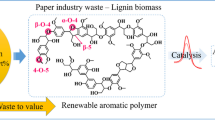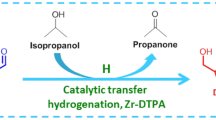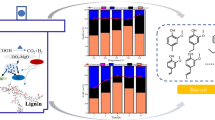Abstract
The Meerwein-Ponndorf-Verley (MPV) reduction is an extremely attractive strategy for the selective hydrogenation of biomass-derived 5-hydroxymethylfurfural (HMF) to 2,5-bis(hydroxymethyl)furan (BHMF) in which constructing a low-cost and high-efficiency catalyst is very essential and crucial. In this work, the enzymatic hydrolysis lignin (EL), which is a waste residue in the production process of lignocellulosic ethanol, was firstly and directly adopted as the cheap organic ligand to prepare a new zirconium-lignin hybrid catalyst (Zr-EL) by a simple solvothermal self-assembly method. Amazingly, Zr-EL displayed superior catalytic activity for the MPV reduction of HMF to BHMF, providing 98.9% yield with a high turnover frequency (TOF) of 10.86 h-1 in 2-propanol (iPrOH) at 140 °C for 4 h. Intensive characterization and analysis results indicated that this superior catalytic activity of Zr-EL was principally attributed to the cooperative effects of Lewis acid-base sites (Zr4+-O2−) under the assistance of good hydrophilicity. Additionally, Zr-EL showed excellent catalytic stability, and when it was recovered and reused for five successive reaction cycles, an apparent loss in the yield of BHMF was not observed. More meaningfully, Zr-EL also exhibited outstanding applicability, allowing it to convert various ketone and aldehyde compounds to the corresponding alcohol products with satisfactory yields in iPrOH via MPV reduction. Conclusively, this work presents a newfangled idea to utilize the low-rank biorefinery residues and construct more practical zirconium-based catalysts for the selective synthesis of high-value chemicals.
Graphical abstract












Similar content being viewed by others

References
Hou Q, Qi X, Zhen M, Qian H, Nie Y, Bai C, Zhang S, Bai X, Ju M (2021) Biorefinery roadmap based on catalytic production and upgrading of 5-hydroxymethylfurfural. Green Chem 23:119–231. https://doi.org/10.1039/d0gc02770g
Thunyaratchatanon C, Sinsakullert W, Luengnaruemitchai A, Faungnawakij K (2021) 5-Hydroxymethylfurfural production from hexose sugars using adjustable acid- and base-functionalized mesoporous SBA-15 catalysts in aqueous media. Biomass Convers Bior 11:1733–1747. https://doi.org/10.1007/s13399-019-00553-8
Graham BJ, Raines RT (2018) Efficient metal-free conversion of glucose to 5-hydroxymethylfurfural using a boronic acid. Biomass Convers Bior 9:471–477. https://doi.org/10.1007/s13399-018-0346-2
Zuo M, Wang X, Wang Q, Zeng X, Lin L (2022) Aqueous-natural deep eutectic solvent (A-NADES) enhanced 5-hydroxymethylfurfural (HMF) production from glucose, starch, and food wastes. ChemSusChem. https://doi.org/10.1002/cssc.202101889
Zuo M, Jia W, Feng Y, Zeng X, Tang X, Sun Y, Lin L (2021) Effective selectivity conversion of glucose to furan chemicals in the aqueous deep eutectic solvent. Renew Energ 164:23–33. https://doi.org/10.1016/j.renene.2020.09.019
Guo D, Liu X, Cheng F, Zhao W, Wen S, Xiang Y, Xu Q, Yu N, Yin D (2020) Selective hydrogenolysis of 5-hydroxymethylfurfural to produce biofuel 2,5-dimethylfuran over Ni/ZSM-5 catalysts. Fuel 274:117853. https://doi.org/10.1016/j.fuel.2020.117853
Xu C, Paone E, Rodriguez-Padron D, Luque R, Mauriello F (2020) Recent catalytic routes for the preparation and the upgrading of biomass derived furfural and 5-hydroxymethylfurfural. Chem Soc Rev 49:4273–4306. https://doi.org/10.1039/d0cs00041h
Thoma C, Konnerth J, Sailer-Kronlachner W, Rosenau T, Potthast A, Solt P, Van Herwijnen HWG (2020) Hydroxymethylfurfural and its derivatives: potential key reactants in adhesives. ChemSusChem 13:5408–5422. https://doi.org/10.1002/cssc.202001539
Hu L, Lin L, Wu Z, Zhou SY, Liu SJ (2017) Recent advances in catalytic transformation of biomass-derived 5-hydroxymethylfurfural into the innovative fuels and chemicals. Renew Sustain Energy Rev 74:230–257. https://doi.org/10.1016/j.rser.2017.02.042
Fulignati S, Antonetti C, Wilbers E, Licursi D, Heeres HJ, Raspolli Galletti AM (2021) Tunable HMF hydrogenation to furan diols in a flow reactor using Ru/C as catalyst. J Ind Eng Chem 100:390.e1-390.e9. https://doi.org/10.1016/j.jiec.2021.04.057
Sarkar C, Paul R, Chandra Shit S, Trinh QT, Koley P, Rao BS, Beale AM, Pao CW, Banerjee A, Mondal J (2021) Navigating copper-atom-pair structural effect inside a porous organic polymer cavity for selective hydrogenation of biomass-derived 5-hydroxymethylfurfural. ACS Sustain Chem Eng 9:2136–2151. https://doi.org/10.1021/acssuschemeng.0c07594
Dutta S (2021) Valorization of biomass-derived furfurals: Reactivity patterns, synthetic strategies, and applications. Biomass Convers Bior. https://doi.org/10.1007/s13399-021-01924-w
Hu L, Xu J, Zhou S, He A, Tang X, Lin L, Xu J, Zhao Y (2018) Catalytic advances in the production and application of biomass-derived 2,5-dihydroxymethylfuran. ACS Catal 8:2959–2980. https://doi.org/10.1021/acscatal.7b03530
Vikanova K, Redina E, Kapustin G, Chernova M, Tkachenko O, Nissenbaum V, Kustov L (2021) Advanced room-temperature synthesis of 2,5-bis(hydroxymethyl)furan: a monomer for biopolymers from 5-hydroxymethylfurfural. ACS Sustain Chem Eng 9:1161–1171. https://doi.org/10.1021/acssuschemeng.0c06560
Feng Y, Long S, Chen B, Jia W, Xie S, Sun Y, Tang X, Yang S, Zeng X, Lin L (2021) Inducing electron dissipation of pyridinic N enabled by single Ni–N4 sites for the reduction of aldehydes/ketones with ethanol. ACS Catal 11:6398–6405. https://doi.org/10.1021/acscatal.1c01386
Wei J, Wang T, Liu H, Liu Y, Tang X, Sun Y, Zeng X, Lei T, Liu S, Lin L (2020) Assembly of Zr-based coordination polymer over USY zeolite as a highly efficient and robust acid catalyst for one-pot transformation of fructose into 2,5-bis(isopropoxymethyl)furan. J Catal 389:87–98. https://doi.org/10.1016/j.jcat.2020.05.020
Gupta D, Saha B (2018) Dual acidic titania carbocatalyst for cascade reaction of sugar to etherified fuel additives. Catal Commun 110:46–50. https://doi.org/10.1016/j.catcom.2018.02.026
Musolino M, Ginés-Molina MJ, Moreno-Tost R, Aricò F (2019) Purolite-catalyzed etherification of 2,5-bis(hydroxymethyl)furan: a systematic study. ACS Sustain Chem Eng 7:10221–10226. https://doi.org/10.1021/acssuschemeng.9b01413
Zhao W, Huang Z, Yang L, Liu X, Xie H, Liu Z (2022) Highly efficient syntheses of 2,5-bis(hydroxymethyl)furan and 2,5-dimethylfuran via the hydrogenation of biomass-derived 5-hydroxymethylfurfural over a nickel-cobalt bimetallic catalyst. Appl Surf Sci 577:151869. https://doi.org/10.1016/j.apsusc.2021.151869
Liu F, Audemar M, De Oliveira Vigier K, Clacens JM, De Campo F, Jerome F (2014) Palladium/carbon dioxide cooperative catalysis for the production of diketone derivatives from carbohydrates. ChemSusChem 7:2089–2093. https://doi.org/10.1002/cssc.201402221
Zhu MM, Du XL, Zhao Y, Mei BB, Zhang Q, Sun FF, Jiang Z, Liu YM, He HY, Cao Y (2019) Ring-opening transformation of 5-hydroxymethylfurfural using a golden single-atomic-site palladium catalyst. ACS Catal 9:6212–6222. https://doi.org/10.1021/acscatal.9b00489
Gelmini A, Albonetti S, Cavani F, Cesari C, Lolli A, Zanotti V, Mazzoni R (2016) Oxidant free one-pot transformation of bio-based 2,5-bis-hydroxymethylfuran into α-6-hydroxy-6-methyl-4-enyl-2H-pyran-3-one in water. Appl Catal B: Environ 180:38–43. https://doi.org/10.1016/j.apcatb.2015.06.003
Lăcătuş MA, Bencze LC, Toşa MI, Paizs C, Irimie FD (2018) Eco-friendly enzymatic production of 2,5-bis(hydroxymethyl)furan fatty acid diesters, potential biodiesel additives. ACS Sustain Chem Eng 6:11353–11359. https://doi.org/10.1021/acssuschemeng.8b01206
Lillie LM, Tolman WB, Reineke TM (2017) Structure/property relationships in copolymers comprising renewable isosorbide, glucarodilactone, and 2,5-bis(hydroxymethyl)furan subunits. Poly Chem 8:3746–3754. https://doi.org/10.1039/c7py00575j
Oh C, Choi EH, Choi EJ, Premkumar T, Song C (2020) Facile solid-state mechanochemical synthesis of eco-friendly thermoplastic polyurethanes and copolymers using a biomass-derived furan diol. ACS Sustain Chem Eng 8:4400–4406. https://doi.org/10.1021/acssuschemeng.9b06944
Pomeroy B, Grilc M, Likozar B (2021) Process condition-based tuneable selective catalysis of hydroxymethylfurfural (HMF) hydrogenation reactions to aromatic, saturated cyclic and linear poly-functional alcohols over Ni-Ce/Al2O3. Green Chem 23:7996–8002. https://doi.org/10.1039/d1gc02086b
Yang Z, Zhang J, Qian G, Duan X, Zhou X (2021) Production of biomass derived monomers through catalytic conversion of furfural and hydroxymethylfurfural. Green Chem Eng 2:158–173. https://doi.org/10.1016/j.gce.2020.11.001
Hu L, Li N, Dai X, Guo Y, Jiang Y, He A, Xu J (2019) Highly efficient production of 2,5-dihydroxymethylfuran from biomass-derived 5-hydroxymethylfurfural over an amorphous and mesoporous zirconium phosphonate catalyst. J Energy Chem 37:82–92. https://doi.org/10.1016/j.jechem.2018.12.001
Zhang J, Qi Z, Liu Y, Wei J, Tang X, He L, Peng L (2020) Selective hydrogenation of 5-hydroxymethylfurfural into 2,5-bis(hydroxymethyl)furan over a cheap carbon-nanosheets-supported Zr/Ca bimetallic catalyst. Energy Fuels 34:8432–8439. https://doi.org/10.1021/acs.energyfuels.0c01128
Hu L, Dai XL, Li N, Tang X, Jiang YT (2019) Highly selective hydrogenation of biomass-derived 5-hydroxymethylfurfural into 2,5-bis(hydroxymethyl)furan over an acid–base bifunctional hafnium-based coordination polymer catalyst. Sustain Energ Fuels 3:1033–1041. https://doi.org/10.1039/c8se00545a
Upare PP, Hwang YK, Hwang DW (2018) An integrated process for the production of 2,5-dihydroxymethylfuran and its polymer from fructose. Green Chem 20:879–885. https://doi.org/10.1039/c7gc03597g
Hao CH, Guo XN, Pan YT, Chen S, Jiao ZF, Yang H, Guo XY (2016) Visible-light-driven selective photocatalytic hydrogenation of cinnamaldehyde over Au/SiC catalysts. J Am Chem Soc 138:9361–9364. https://doi.org/10.1021/jacs.6b04175
Liu X, Leong DCY, Sun Y (2020) The production of valuable biopolymer precursors from fructose. Green Chem 22:6531–6539. https://doi.org/10.1039/d0gc02315a
Roylance JJ, Kim TW, Choi KS (2016) Efficient and selective electrochemical and photoelectrochemical reduction of 5-hydroxymethylfurfural to 2,5-bis(hydroxymethyl)furan using water as the hydrogen source. ACS Catal 6:1840–1847. https://doi.org/10.1021/acscatal.5b02586
Li G, Sun Z, Yan YE, Zhang YH, Tang Y (2017) Direct transformation of HMF into 2,5-diformylfuran and 2,5-dihydroxymethylfuran without an external oxidant or reductant. ChemSusChem 10:494–498. https://doi.org/10.1002/cssc.201601322
Xu L, Nie R, Chen X, Li Y, Jiang Y, Lu X (2021) Formic acid enabled selectivity boosting in transfer hydrogenation of 5-hydroxymethylfurfural to 2,5-furandimethanol on highly dispersed Co–Nx sites. Catal Sci Technol 11:1451–1457. https://doi.org/10.1039/d0cy01969k
Chen D, Cang R, Zhang ZD, Huang H, Zhang ZG, Ji XJ (2021) Efficient reduction of 5-hydroxymethylfurfural to 2,5-bis (hydroxymethyl) furan by a fungal whole-cell biocatalyst. Mol Catal 500:111341. https://doi.org/10.1016/j.mcat.2020.111341
He Y, Jiang C, Chong G, Di J, Ma C (2018) Biological synthesis of 2,5-bis(hydroxymethyl)furan from biomass-derived 5-hydroxymethylfurfural by E. coli CCZU-K14 whole cells. Bioresour Technol 247:1215–1220. https://doi.org/10.1016/j.biortech.2017.09.071
Zhang S, Ma C, Li Q, Li Q, He Y (2022) Efficient chemoenzymatic valorization of biobased D-fructose into 2,5-bis(hydroxymethyl)furan with deep eutectic solvent Lactic acid: Betaine and Pseudomonas putida S12 whole cells. Bioresour Technol 344:126299. https://doi.org/10.1016/j.biortech.2021.126299
He Y, Ding Y, Ma C, Di J, Jiang C, Li A (2017) One-pot conversion of biomass-derived xylose to furfuralcohol by a chemo-enzymatic sequential acid catalyzed dehydration and bioreduction. Green Chem 19:3844–3850. https://doi.org/10.1039/C7GC01256J
Li Q, Ren J, Li Q, Di J, Ma C, He Y (2021) Sustainable conversion of biomass-derived D-xylose to furfuryl alcohol in a deep eutectic solvent-water system. ACS Sustain Chem Eng 9:10299–10308. https://doi.org/10.1021/acssuschemeng.1c02965
Farrar-Tobar RA, Dell’Acqua A, Tin S, De Vries JG (2020) Metal-catalysed selective transfer hydrogenation of α, β-unsaturated carbonyl compounds to allylic alcohols. Green Chem 22:3323–3357. https://doi.org/10.1039/d0gc00855a
Gilkey MJ, Xu BJ (2016) Heterogeneous catalytic transfer hydrogenation as an effective pathway in biomass upgrading. ACS Catal 6:1420–1436. https://doi.org/10.1021/acscatal.5b02171
Jin X, Yin B, Xia Q, Fang T, Shen J, Kuang L, Yang C (2019) Catalytic transfer hydrogenation of biomass-derived substrates to value-added chemicals on dual-function catalysts: opportunities and challenges. ChemSusChem 12:71–92. https://doi.org/10.1002/cssc.201801620
Li H, Liu XF, Yang TT, Zhao WF, Saravanamurugan S, Yang S (2017) Porous zirconium-furandicarboxylate microspheres for efficient redox conversion of biofuranics. ChemSusChem 18:1761–1770. https://doi.org/10.1002/cssc.201601898
Li H, Fang Z, He J, Yang S (2017) Orderly layered Zr-benzylphosphonate nanohybrids for efficient acid-base-mediated bifunctional/cascade catalysis. ChemSusChem 10:681–686. https://doi.org/10.1002/cssc.201601570
Hu L, Liu S, Song J, Jiang Y, He A, Xu J (2020) Zirconium-containing organic–inorganic nanohybrid as a highly efficient catalyst for the selective synthesis of biomass-derived 2,5-dihydroxymethylfuran in isopropanol. Waste Biomass Valori 11:3485–3499. https://doi.org/10.1007/s12649-019-00703-z
Leng Y, Shi L, Du S, Jiang J, Jiang P (2020) A tannin-derived zirconium-containing porous hybrid for efficient Meerwein-Ponndorf-Verley reduction under mild conditions. Green Chem 22:180–186. https://doi.org/10.1039/c9gc03393a
Mao H, Chen X, Huang R, Chen M, Yang R, Lan P, Zhou M, Zhang F, Yang Y, Zhou X (2018) Fast preparation of carbon spheres from enzymatic hydrolysis lignin: effects of hydrothermal carbonization conditions. Sci Rep 8:9501. https://doi.org/10.1038/s41598-018-27777-4
Zhou S, Dai F, Xiang Z, Song T, Liu D, Lu F, Qi H (2019) Zirconium-lignosulfonate polyphenolic polymer for highly efficient hydrogen transfer of biomass-derived oxygenates under mild conditions. Appl Catal B: Environ 248:31–43. https://doi.org/10.1016/j.apcatb.2019.02.011
Abu-Omar MM, Barta K, Beckham GT, Luterbacher JS, Ralph J, Rinaldi R, Román-Leshkov Y, Samec JSM, Sels BF, Wang F (2021) Guidelines for performing lignin-first biorefining. Energy Environ Sci 14:262–292. https://doi.org/10.1039/d0ee02870c
Sun RC (2020) Lignin source and structural characterization. ChemSusChem 13:4385–4393. https://doi.org/10.1002/cssc.202001324
Zhang C, Wang F (2020) Catalytic lignin depolymerization to aromatic chemicals. Acc Chem Res 53:470–484. https://doi.org/10.1021/acs.accounts.9b00573
Xue ZM, Jiang JY, Li GF, Zhao WC, Wang JF, Mu TC (2016) Zirconium-cyanuric acid coordination polymer: highly efficient catalyst for conversion of levulinic acid to γ-valerolactone. Catal Sci Technol 6:5374–5379. https://doi.org/10.1039/C5CY02215K
Hu L, Yang M, Xu N, Xu JX, Zhou SY, Chu XZ, Zhao YJ (2018) Selective transformation of biomass-derived 5-hydroxymethylfurfural into 2,5-dihydroxymethylfuran via catalytic transfer hydrogenation over magnetic zirconium hydroxides. Korean J Chem Eng 35:99–109. https://doi.org/10.1007/s11814-017-0238-3
Liu X, Cheng X (2007) Study on the separation and structure of enzymatic hydrolysis lignin. J Cell Sci Technol 15:41–47. https://doi.org/10.16561/j.cnki.xws.2007.03.011
Hao WW, Li WF, Tang X, Zeng XH, Sun Y, Liu SJ, Lin L (2016) Catalytic transfer hydrogenation of biomass-derived 5-hydroxymethyl furfural to the building block 2,5-bishydroxymethyl furan. Green Chem 18:1080–1088. https://doi.org/10.1039/C5GC01221J
Hu L, Li T, Xu J, He A, Tang X, Chu X, Xu J (2018) Catalytic transfer hydrogenation of biomass-derived 5-hydroxymethylfurfural into 2,5-dihydroxymethylfuran over magnetic zirconium-based coordination polymer. Chem Eng J 352:110–119. https://doi.org/10.1016/j.cej.2018.07.007
Van Der Waal JC, Kunkeler PJ, Tan K, Van Bekkum H (1998) Zeolite titanium beta: a selective catalyst for the gas-phase Meerwein-Ponndorf-Verley-Oppenauer reactions. J Catal 173:74–83. https://doi.org/10.1006/jcat.1997.1901
Fan Y, Zhuang C, Li S, Wang Y, Zou X, Liu X, Huang W, Zhu G (2021) Efficient single-atom Ni for catalytic transfer hydrogenation of furfural to furfuryl alcohol. J Mater Chem A 9:1110–1118. https://doi.org/10.1039/d0ta10838c
Zhou S, Dai F, Chen Y, Dang C, Zhang C, Liu D, Qi H (2019) Sustainable hydrothermal self-assembly of hafnium-lignosulfonate nanohybrids for highly efficient reductive upgrading of 5-hydroxymethylfurfural. Green Chem 21:1421–1431. https://doi.org/10.1039/c8gc03710h
Elsayed I, Jackson MA, Hassan EB (2020) Hydrogen-free catalytic reduction of biomass-derived 5-hydroxymethylfurfural into 2,5-bis(hydroxymethyl)furan using copper-iron oxides bimetallic catalyst. ACS Sustain Chem Eng 8:1774–1785. https://doi.org/10.1021/acssuschemeng.9b05575
Wan F, Yang B, Zhu J, Jiang D, Zhang H, Zhang Q, Chen S, Zhang C, Liu Y, Fu Z (2021) The transfer hydrogenation of high concentration levulinic acid to γ-valerolactone catalyzed by glucose phosphate carbamide zirconium. Green Chem 23:3428–3438. https://doi.org/10.1039/d1gc00209k
Wang T, Xu H, He J, Zhang Y (2020) MPV reduction of ethyl levulinate to γ-valerolactone by the biomass-derived chitosan-supported Zr catalyst. New J Chem 44:14686–14694. https://doi.org/10.1039/d0nj02667k
Song JL, Zhou BW, Zhou Hc WuLQ, Meng QL, Liu ZM, Han BX (2015) Porous zirconium-phytic acid hybrid: a highly efficient catalyst for Meerwein-Ponndorf-Verley reductions. Angew Chem Int Ed 54:9399–9403. https://doi.org/10.1002/anie.201504001
Li H, He J, Riisager A, Saravanamurugan S, Song B, Yang S (2016) Acid-base bifunctional zirconium N-alkyltriphosphate nanohybrid for hydrogen transfer of biomass-derived carboxides. ACS Catal 6:7722–7727. https://doi.org/10.1021/acscatal.6b02431
Li FK, France LJ, Cai ZP, Li YW, Liu SJ, Lou HM, Long JX, Li XH (2017) Catalytic transfer hydrogenation of butyl levulinate to γ-valerolactone over zirconium phosphates with adjustable Lewis and Brønsted acid sites. Appl Catal B: Environ 214:67–77. https://doi.org/10.1016/j.apcatb.2017.05.013
Hu L, Jiang Y, Wang X, He A, Xu J, Wu Z (2021) Recent advances and mechanistic insights on the production of biomass-derived 2,5-bis(alkoxymethyl)furans. Biomass Convers Bior. https://doi.org/10.1007/s13399-020-01062-9
Li H, Yang TT, Fang Z (2018) Biomass-derived mesoporous Hf-containing hybrid for efficient Meerwein-Ponndorf-Verley reduction at low temperatures. Appl Catal B: Environ 227:79–89. https://doi.org/10.1016/j.apcatb.2018.01.017
Song J, Hua M, Huang X, Visa A, Wu T, Fan H, Hou M, Zhang Z, Han B (2021) Highly efficient Meerwein–Ponndorf–Verley reductions over a robust zirconium-organoboronic acid hybrid. Green Chem 23:1259–1265. https://doi.org/10.1039/d0gc04179c
Fang W, Riisager A (2021) Recent advances in heterogeneous catalytic transfer hydrogenation/hydrogenolysis for valorization of biomass-derived furanic compounds. Green Chem 23:670–688. https://doi.org/10.1039/d0gc03931d
Li FK, Li ZM, France LJ, Mu JL, Song CH, Chen Y, Jiang LL, Long JX, Li XH (2018) Highly efficient transfer hydrogenation of levulinate esters to γ-valerolactone over basic zirconium carbonate. Ind Eng Chem Res 57:10126–10136. https://doi.org/10.1021/acs.iecr.8b00712
Valekar AH, Lee M, Yoon JW, Kwak J, Hong DY, Oh KR, Cha GY, Kwon YU, Jung J, Chang JS, Hwang YK (2020) Catalytic transfer hydrogenation of furfural to furfuryl alcohol under mild conditions over Zr-MOFs: exploring the role of metal node coordination and modification. ACS Catal 10:3720–3732. https://doi.org/10.1021/acscatal.9b05085
Rojas-Buzo S, Garcia-Garcia P, Corma A (2018) Catalytic transfer hydrogenation of biomass-derived carbonyls over hafnium-based metal-organic frameworks. ChemSusChem 11:432–438. https://doi.org/10.1002/cssc.201701708
He J, Li H, Riisager A, Yang S (2017) Catalytic transfer hydrogenation of furfural to furfuryl alcohol with recyclable Al-Zr@Fe mixed oxides. ChemCatChem 10:430–438. https://doi.org/10.1002/cctc.201701266
Funding
This work was financially supported by the Natural Science Foundation of Jiangsu Province (BK20190105, BK20191056, and BK20201072), the National Natural Science Foundation of China (22078123, 21908075, and 22108091), the Natural Science Foundation of the Higher Education Institutions of Jiangsu Province (18KJB416003 and 19KJB220006), the Natural Science Foundation of Huaian City (HAB202057), the College Students’ Innovative Entrepreneurial Training Plan Program of Jiangsu Province (202118009XJ), and the Qinglan Project of Jiangsu Province.
Author information
Authors and Affiliations
Contributions
Yameng Zhang and Xinming Shen: Methodology, investigation, writing (original draft). Zhen Wu and Xiaoyu Wang: Formal analysis, writing (review and editing), supervision. Lei Hu and Yetao Jiang: Conceptualization, methodology, writing (review and editing), supervision, project administration.
Corresponding authors
Ethics declarations
Conflict of interest
The authors declare no competing interests.
Additional information
Publisher's Note
Springer Nature remains neutral with regard to jurisdictional claims in published maps and institutional affiliations.
Yameng Zhang and Xinming Shen are contributed equally
Supplementary Information
Below is the link to the electronic supplementary material.
Rights and permissions
About this article
Cite this article
Zhang, Y., Shen, X., Hu, L. et al. Zirconium-lignin hybrid catalyst for the Meerwein-Ponndorf-Verley reduction of biomass-derived 5-hydroxymethylfurfural to 2,5-bis(hydroxymethyl)furan. Biomass Conv. Bioref. 14, 2045–2061 (2024). https://doi.org/10.1007/s13399-022-02381-9
Received:
Revised:
Accepted:
Published:
Issue Date:
DOI: https://doi.org/10.1007/s13399-022-02381-9



